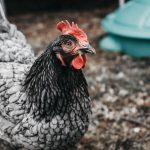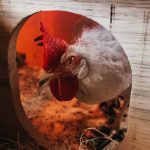Raising chickens and turkeys on a farm can be a profitable and fulfilling endeavor. These poultry species are popular among small-scale farmers and homesteaders due to their relatively low maintenance requirements and diverse product offerings, including eggs, meat, and feathers. Chickens are primarily valued for their egg production, while turkeys are typically raised for their meat.
When properly managed, chickens and turkeys can coexist in close proximity, providing a sustainable food source for the farm. However, housing these birds together requires careful consideration of several factors to ensure the health and well-being of both species. Proper management practices, including appropriate housing, nutrition, and disease prevention, are essential for successful poultry farming.
Table of Contents
- 1 Benefits of Keeping Chickens and Turkeys in Close Quarters
- 2 Considerations for Housing Chickens and Turkeys Together
- 3 Potential Health Risks and Disease Management
- 4 Feeding and Nutrition for Chickens and Turkeys in Close Quarters
- 5 Managing Behavioral Issues and Social Dynamics
- 6 Best Practices for Keeping Chickens and Turkeys in Close Quarters
- 7 FAQs
- 7.1 Can you keep chickens and turkeys in close quarters on a farm?
- 7.2 What are the considerations for keeping chickens and turkeys in close quarters?
- 7.3 What are the space requirements for chickens and turkeys in close quarters?
- 7.4 What are the specific needs for food, water, and shelter for chickens and turkeys in close quarters?
- 7.5 What are the risks of keeping chickens and turkeys in close quarters?
- 7.6 What are some tips for keeping chickens and turkeys in close quarters?
Key Takeaways
- Raising chickens and turkeys on a farm can be a rewarding and sustainable practice for small-scale farmers.
- Keeping chickens and turkeys in close quarters can lead to benefits such as efficient use of space and resources, as well as improved social dynamics among the birds.
- When housing chickens and turkeys together, it is important to consider factors such as space requirements, nesting areas, and predator protection.
- Potential health risks and disease management are crucial considerations when keeping chickens and turkeys in close quarters to prevent the spread of illnesses.
- Feeding and nutrition for chickens and turkeys in close quarters should be carefully managed to ensure proper growth and overall health of the birds.
Benefits of Keeping Chickens and Turkeys in Close Quarters
Efficient Use of Resources
One of the main benefits of keeping chickens and turkeys in close quarters is the efficient use of space and resources. By housing these birds together, farmers can maximize the use of their available land and infrastructure, reducing the overall cost of production.
Complementary Foraging Behaviors
Chickens and turkeys have different foraging behaviors, which allows them to coexist without competing for the same food sources. Chickens scratch and peck at the ground for insects and seeds, while turkeys are more likely to graze on grass and other vegetation. This makes it easier to manage their feeding and nutrition.
Mutual Predator Protection
Both chickens and turkeys can benefit from each other’s presence in terms of predator protection. Chickens are known to be more vigilant and vocal in the presence of predators, which can help alert turkeys to potential threats. On the other hand, turkeys are larger and more imposing, which can deter some predators from approaching the coop or pen.
A Symbiotic Relationship
Overall, keeping chickens and turkeys in close quarters can create a symbiotic relationship that benefits both species and the farm as a whole.
Considerations for Housing Chickens and Turkeys Together

When housing chickens and turkeys together, there are several important considerations to take into account. Firstly, it’s essential to provide adequate space for both species to move around freely and engage in natural behaviors. Overcrowding can lead to stress, aggression, and an increased risk of disease transmission.
Additionally, it’s important to consider the different housing requirements of chickens and turkeys. For example, turkeys require higher perches or roosts compared to chickens due to their larger size and weight. Providing separate nesting areas for each species can also help reduce competition and potential conflicts over nesting sites.
Furthermore, it’s crucial to monitor the social dynamics within the flock, as both chickens and turkeys have distinct pecking orders and hierarchies. Introducing new birds or rearranging the flock can disrupt these social structures, leading to aggression and stress. Therefore, careful observation and management of the flock’s dynamics are essential for maintaining harmony within the coop or pen.
Potential Health Risks and Disease Management
One of the potential challenges of keeping chickens and turkeys in close quarters is the increased risk of disease transmission between the two species. Chickens are known carriers of various diseases, such as coccidiosis and infectious bronchitis, which can be transmitted to turkeys if proper precautions are not taken. Additionally, turkeys are susceptible to blackhead disease, which is caused by a parasite that is commonly found in chicken droppings.
To mitigate these risks, it’s important to practice good biosecurity measures, such as regular cleaning and disinfection of the coop or pen, as well as separating sick or injured birds from the rest of the flock. Furthermore, providing separate feeding and watering stations for chickens and turkeys can help reduce the likelihood of disease transmission through shared resources. It’s also advisable to consult with a veterinarian or poultry health expert to develop a comprehensive disease management plan tailored to the specific needs of the farm.
Feeding and Nutrition for Chickens and Turkeys in Close Quarters
Feeding and nutrition are crucial aspects of raising chickens and turkeys in close quarters. Both species have distinct dietary requirements, with chickens needing a higher protein content for egg production, while turkeys require a more balanced diet for optimal growth and development. When housing chickens and turkeys together, it’s important to provide a well-balanced feed that meets the nutritional needs of both species.
Additionally, offering supplemental sources of calcium, such as oyster shells for chickens, can help ensure strong eggshells and overall health. It’s also important to monitor the feeding behavior of both chickens and turkeys to prevent competition over food resources. Providing multiple feeding stations can help reduce aggression and ensure that all birds have access to adequate nutrition.
Furthermore, offering a diverse range of treats and foraging opportunities can help stimulate natural behaviors and reduce boredom within the flock.

Managing behavioral issues and social dynamics within a mixed flock of chickens and turkeys requires careful observation and proactive intervention. Both species have distinct social structures and communication methods, which can lead to conflicts if not properly managed. For example, chickens may exhibit aggressive behavior towards turkeys during feeding time or when establishing a pecking order within the flock.
Mitigating Conflicts and Reducing Aggression
To mitigate these issues, providing ample space, multiple feeding stations, and environmental enrichment can help reduce competition and aggression. Additionally, monitoring the flock for signs of stress or injury can help identify potential issues before they escalate. Introducing new birds gradually and providing adequate hiding spots or escape routes within the coop or pen can also help reduce social tension within the flock.
Proactive Management for a Harmonious Environment
Overall, proactive management of behavioral issues and social dynamics is essential for maintaining a harmonious environment for both chickens and turkeys. By understanding the social structures and communication methods of both species and taking steps to mitigate conflicts, you can create a peaceful and thriving mixed flock.
Best Practices for Keeping Chickens and Turkeys in Close Quarters
In conclusion, raising chickens and turkeys in close quarters can be a rewarding endeavor that provides a sustainable source of food for the farm. By maximizing space and resources, managing social dynamics, and implementing good biosecurity measures, farmers can successfully house these two species together while minimizing potential risks. Providing adequate space, separate housing areas, balanced nutrition, disease management protocols, and proactive management of social dynamics are essential best practices for keeping chickens and turkeys in close quarters.
With careful planning and attention to the specific needs of each species, farmers can create a thriving environment where chickens and turkeys coexist harmoniously, contributing to a successful and sustainable farm operation.
If you’re considering keeping chickens and turkeys in close quarters, it’s important to ensure that your coop is properly designed to accommodate both species. According to a helpful article on PoultryWizard, “Chicken Coop Muskegon,” it’s crucial to provide enough space and nesting boxes for both chickens and turkeys to coexist peacefully. Additionally, the article “Chicken Coop Door Size” offers valuable insights into the importance of having a properly sized door to allow for easy access and ventilation for both types of birds. For more information on creating a suitable coop for chickens and turkeys, check out the article “Chicken Coop Nest Box” for tips on providing adequate nesting space for both species. https://poultrywizard.com/keeping-chickens/chicken-coop-nest-box/
FAQs
Can you keep chickens and turkeys in close quarters on a farm?
Yes, it is possible to keep chickens and turkeys in close quarters on a farm. However, there are some important considerations to keep in mind when doing so.
What are the considerations for keeping chickens and turkeys in close quarters?
When keeping chickens and turkeys in close quarters, it is important to consider the space requirements for each bird, as well as their specific needs for food, water, and shelter. Additionally, it is important to monitor for any signs of aggression or disease, as close quarters can increase the risk of these issues.
What are the space requirements for chickens and turkeys in close quarters?
Chickens generally require about 2-3 square feet of space per bird in a coop, while turkeys require about 8-10 square feet of space per bird. It is important to ensure that there is enough space for each bird to move around comfortably and engage in natural behaviors.
What are the specific needs for food, water, and shelter for chickens and turkeys in close quarters?
Chickens and turkeys require access to clean water and a balanced diet of feed that meets their nutritional needs. Additionally, they need shelter that provides protection from predators and the elements.
What are the risks of keeping chickens and turkeys in close quarters?
Keeping chickens and turkeys in close quarters can increase the risk of aggression between birds, as well as the spread of disease. It is important to monitor the birds closely and take steps to prevent and address any issues that may arise.
What are some tips for keeping chickens and turkeys in close quarters?
Some tips for keeping chickens and turkeys in close quarters include providing ample space, ensuring access to clean water and a balanced diet, monitoring for signs of aggression or disease, and providing appropriate shelter and protection. Regular cleaning and maintenance of the coop and surrounding areas can also help minimize risks.
Meet Walter, the feathered-friend fanatic of Florida! Nestled in the sunshine state, Walter struts through life with his feathered companions, clucking his way to happiness. With a coop that’s fancier than a five-star hotel, he’s the Don Juan of the chicken world. When he’s not teaching his hens to do the cha-cha, you’ll find him in a heated debate with his prized rooster, Sir Clucks-a-Lot. Walter’s poultry passion is no yolk; he’s the sunny-side-up guy you never knew you needed in your flock of friends!







